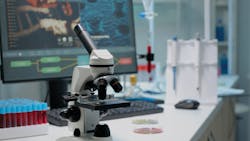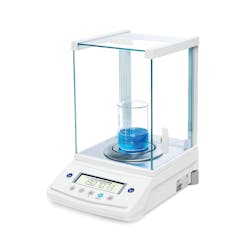The importance of metrological traceability within clinical laboratories
Metrological traceability is defined by the International Vocabulary of Metrology (VIM) as “the property of a measurement result whereby the result can be related to a reference through a documented unbroken chain of calibration, each contributing to the measurement uncertainty.”1 Within this definition of metrological traceability, there are three notes:
Note 1: For this definition, a ‘reference’ can be a definition of a measurement unit through its practical realization, or a measurement procedure including the measurement unit for a non-ordinal quantity, or a measurement standard.
Note 2: Metrological traceability requires an established calibration hierarchy.
Note 3: Specification of the reference must include the time at which this reference was used in establishing the calibration hierarchy, along with any other relevant metrological information about the reference, such as when the first calibration in the calibration hierarchy was performed.
Metrological traceability can be characterized by the following seven essential elements:
- The measurement(s) must be defined (preferably within the International System of Units).
- Unbroken chain of comparisons to calibrations and measurements.
- Documented calibration program where calibrations are repeated at established and appropriate intervals to preserve metrological traceability over time.
- Documented measurement uncertainty for each step in the traceability chain must be calculated according to defined methods and must be documented so that the laboratory can determine the margin in which the true value of a result lies.
- Documented measurement procedures that guide performance of calibrations and measurements.
- Proof of competence of the library through accreditation.
- A measurement assurance program must be established to ensure the validity of the measurement process and the accuracy of standard used at the time of the measurement.2
The definition of metrological traceability is inclusive of equipment, reference measurement standards, and reference materials that a laboratory uses.
How to establish metrological traceability within a laboratory
Metrological traceability is not only important to a clinical laboratory seeking ISO 15189 accreditation, but it is critical to ensuring the validity of clinical results. There are numerous ways for a laboratory to establish measurement traceability based on the item that they are using. For equipment and reference measurement standards, a laboratory can perform in-house calibrations on items or an external calibration service can conduct the calibration. For both types of calibrations, there are additional requirements a laboratory must follow. When a laboratory is performing in-house calibrations, a laboratory must have a documented procedure for in-house calibrations, demonstrate traceability to national or international standards, determine measurement uncertainty, and have a policy or a procedure in place to establish and change calibration intervals. In addition to these requirements, a laboratory must maintain numerous records such as calibration reports and training records of calibration personnel.
Another way a laboratory can establish metrological traceability is with reference materials. A laboratory will have a few options to choose from when they are searching for a reference material. First, a laboratory may choose to use a reference material producer that is accredited to ISO 17034 that is covered by the International Laboratory Accreditation Cooperation (ILAC) or by a regional arrangement recognized by ILAC. Second, a laboratory may choose to have a reference material come from an NMI. Third, a laboratory may choose to have a reference material with certified values that are covered by entries in the Joint Committee for Traceability in Laboratory Medicine (JCTLM) database. It is important to note that there may not be certified reference materials for all analytes.
The role of metrological traceability in the clinical laboratory
Metrological traceability in a clinical laboratory ensures that the measurement result is traceable and that there is a consistency or a comparability of measurement results. In an example provided by Querry and Tholen, “Metrological traceability helps ensure that we are comparing apples to apples and, furthermore, that we are comparing a Gala apple to a Gala apple — and with what level of certainty we can say that our Gala apple is indeed a Gala apple.”3 This example breaks down the basic idea behind metrological traceability.
While this example breaks down the basic ideas behind metrological traceability, there are numerous examples of metrological traceability that can be seen within the clinical laboratory. When a laboratory is using a thermometer as part of their procedures, a laboratory may get their reference thermometer calibrated by an accredited ISO/IEC 17025 calibration laboratory. The laboratory should ensure that they receive an endorsed calibration certificate. Another example a laboratory may see is if the laboratory is using a pH buffer for one of their tests. If the laboratory is using a buffer solution, pH 4, then they will want to obtain this buffer from a reference material producer or from an NMI. A laboratory may find an ISO 17034 reference material producer that they can purchase this reference material from or a laboratory could purchase this reference material straight from NIST.
In healthcare, reducing method variability provides confidence in the data that is provided by a laboratory to make critical decisions on the care of a patient. If a laboratory does not consider metrological traceability when they are running their testing, it could lead to inconsistent results or inaccurate results. When a laboratory is dealing with inconsistent results, this not only has a major impact on the confidence in the laboratory, but more importantly, it could have major implications on the care the patient is receiving based off the results.
Achieving metrological traceability
The traceability of a measurement result in the laboratory is achieved by the following:
- Use equipment certified through an accredited calibration provider.4
- Use equipment in the calibrated rage.
- Train staff on equipment use.
- Ensure staff are trained and competent to make measurements.
- Use a documented procedure for measurements.5
- Calculate measurement results and their associated uncertainty according to the procedure.
Conclusion
Metrological traceability is typically thought about just as an extra step for a laboratory to complete, but it is extremely important to reducing method variability that may occur within the laboratory. Laboratories do have many choices in how they choose to achieve metrological traceability depending on if the laboratory is using a reference material, piece of equipment, or reference measurement standard. If a laboratory follows a straightforward process, it will not only be able to establish metrological traceability for testing within their laboratory, but a laboratory will be able to improve the results it provides. Metrological traceability is an important piece in the care that patients receive due to improving the accuracy of results provided by the laboratory.
References
- International Vocabulary of Metrology – Basic and General Concepts and Associated Terms VIM, 3rd edition, JCGM 200:2012 (JCGM 200:2008 with minor corrections). file:///C:/Users/BTGAdmin/Downloads/JCGM_200_2012.pdf.
- Harris GL. Selected Laboratory and Measurement Practices and Procedures to Support Basic Mass Calibrations: 2019 Edition. National Institute of Standards and Technology.
- Querry R, Tholen DW. Metrological traceability of test results. Medical Laboratory Observer. Published July 25, 2017. Accessed August 24, 2022. https://www.mlo-online.com/home/article/13009229/metrological-traceability-of-test-results.
- One way of finding an appropriate calibration provider would be to search an accreditation organizations website that accredits calibration laboratories to ISO/IEC 17025. A2LA has a list of all the currently A2LA accredited calibration providers along with their scope of accreditation listed on a searchable database to make it easier for laboratories to narrow down their search based off of specific criteria, available at: https://customer.a2la.org/index.cfm?event=directory.index.
- JCTLM created a database for laboratory medicine and in vitro diagnostics where laboratories can search for reference materials, measurement methods/procedures, and services that are related to the work that they are conducting. This database is available at: https://www.bipm.org/jctlm/.
About the Author

Carlyn Mathews
is the Clinical Program Manager at A2LA, one of the largest accreditation bodies in the world and the only independent, internationally recognized accreditation body in the United States that offers a full range of comprehensive conformity assessment accreditation services. Carlyn works closely with clinical laboratories to help them achieve and maintain accreditation to federal and global standards.

